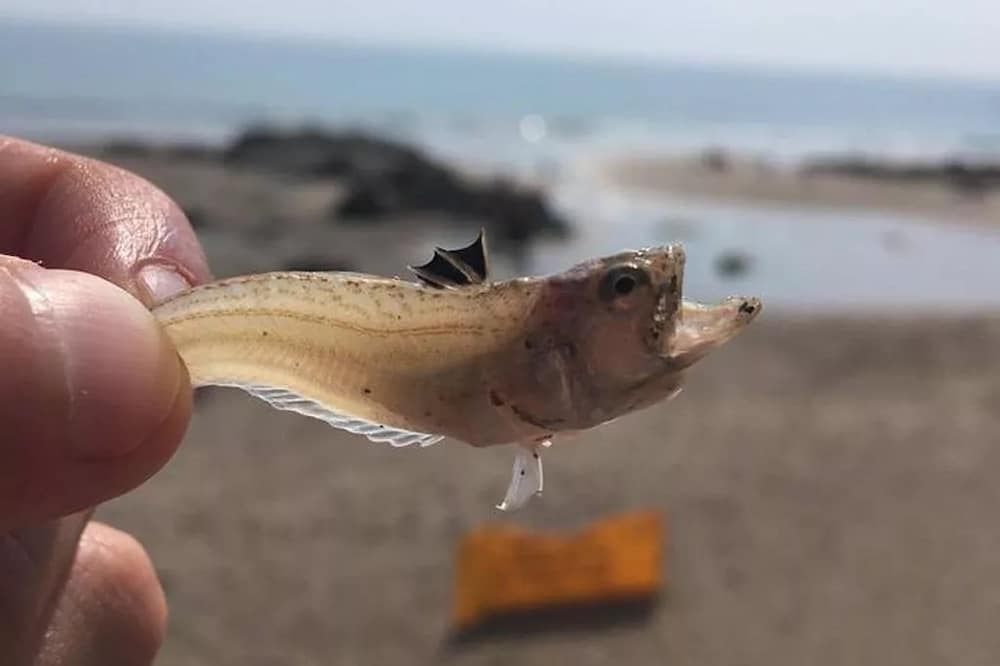
Photo: @RNLI Lifeguards_South East Cornwall
Ask most British surfers what they fear most in the water and it’s not GW’s, Tigers, sea snakes or fire coral. It’s the tiny weever fish that for some reason carries enough hurty poison in its tiny spikey fins to put a cobra to shame.
…And they’re back!
Yes, it’s that time of year when our old friends the Weever Fish rear their ugly little heads, and stings, from the sand in the UK…
If you’ve ever felt a sudden, burning pain while walking into the sea barefoot, you might have met one of the UK’s lesser-known hazards: the weever fish. These tiny, sand-dwelling fish pack a venomous punch—and every summer, surfers, swimmers, and beachgoers fall victim to their stings.
Here’s everything you need to know to stay safe (and keep the session going) this season.
What Is a Weever Fish?
Weever fish are small, spiny little fish that bury themselves in sandy shallows—right where we tend to paddle out, wade, or carry our boards. The most common type in the UK is the lesser weever (Echiichthys vipera), which grows to about 10–15cm.
They’re hard to spot because they bury themselves in leaving only their eyes and venomous spines sticking out—perfect for unsuspecting feet to find. “Ambush” and “pure evil” some would say!
Why Do They Sting?
Allegedly they don’t go looking for a fight…Yeah right! And the sting is purely defensive—caused by sharp, venomous spines along their dorsal fin and gills. When stepped on or disturbed ( You don’t even have to took at them), the vindictive little shore break dwellers jab the spines into your skin and inject venom.
The pain is no joke—often described as burning, intense, and immediate. You’ll usually know right away. As a lifeguard I saw grown men shedding tears!
What Does a Sting Feel Like?
-
Sharp, burning pain (starts within minutes) and can spread up limbs and last for hours, sometimes days
-
Redness and swelling
-
In some cases: nausea, dizziness, or feeling faint
While incredibly painful, stings are rarely dangerous unless there’s an allergic reaction. Intensity varies from person to person, and with depth of injection. For some people it’s an inconvenience, while some have had to go to hospital after reactions. The sting can lead to mild discomfort lead, some to swelling, or in same cases cause discomfort that last days. It’s all a bit of a lottery. But once you know, you know!
How to Treat a Weever Fish Sting
If you or someone else gets stung:
-
Get out of the water.
-
Immerse the affected area in hot water (around 40–45°C) for 30–90 minutes. The heat breaks down the venom. Start what warm water and add hotter water part by part until it is as hot as you can stand.
-
Remove any spines with tweezers and clean the wound.
-
Take painkillers like ibuprofen or paracetamol if needed.
-
Get medical help if the pain doesn’t subside, if there’s a bad reaction, or if you’re unsure about the sting.
Pro tip: Surf schools and lifeguard stations often have buckets and thermos flasks ready for this exact reason.
Where Are They Found?
Weever fish show up all around the UK coast.
They’re most active from June to September, when water temps rise and beach activity peaks. Coincidence or strategy? You decide!
How Common Are Stings?
While there’s no exact national count, weever stings are common enough that lifeguards deal with them regularly during the summer. In popular surf spots like Newquay or Perranporth, there can be dozens of cases a week during hot spells.
Most go unreported because they’re treated on the beach or at home.
How to Avoid Getting Stung
-
Wear wetsuit boots —especially when walking into the water.
-
Shuffle your feet instead of stepping—this warns fish and gives them time to move.
Stay safe out there!





